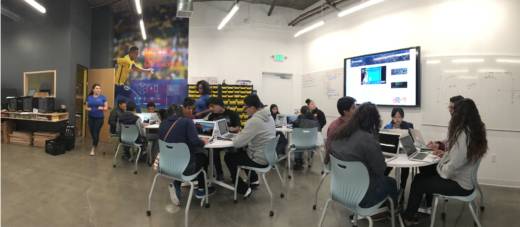"Everything’s just a big puzzle," Fornes said. "Like if something doesn’t work, you have to rearrange almost everything."
And that process is similar to coding, said April Alvarez, the after-school program's experience manager. She was part of a team that worked with community members and students to develop the program.
The idea is simple: coding is also making, and it takes the same problem-solving skills as making stuff in real life. Google teamed up with MIT’s Media Lab to create the Code Next curriculum.
The lab space where students work is the size of a classroom, only with a 3-D printer and laser cutter along one wall. The lab has an industrial feel; the floors are concrete, the ceiling is exposed. Alvarez said the architecture has been carefully planned to reflect Code Next’s teaching philosophy.
"We wanted kids to see the inner workings of this space," she said. "We want them to see the pipes, the wiring, everything that makes this place work."
Instead of lectures on programming, students at Code Next are assigned projects -- like making a board game. Instead of teachers, Code Next has coaches. Many are trained classroom teachers, though they don’t necessarily have coding skills. Together, the students and coaches figure out how to make stuff.
Bryson Gauff is a coach and was helping students create the graphics for a sticker on the computer.
"What’s been really cool for me is, not being a coder, learning with the kids," Guaff said.
Creating a New Model
Hadi Partovi has done a lot of thinking about how to teach computer programming in elementary and high schools. He’s the CEO and co-founder of Code.org, a nonprofit that provides computer science curriculum and teacher training to K-12 schools. Code.org is used in about 120 school districts nationwide and is funded by tech companies like Microsoft, Facebook and Google.
"These are relatively new ideas," Partovi said. "They’re broadly seen as a way to get students engaged but they’re not broadly used."
Partovi said in college he learned computer programing by taking notes while listening to an expert programmer give a lecture. He says that approach generally works for students who are already into coding, but it’s failed to hook students who aren’t. And it’s these students educators need to reach.
Last year more than 600,000 tech jobs went unfilled in the United States. Tech companies and the Obama administration have pushed to make computer science a part of the K-12 curriculum. But even in California, home of Silicon Valley, a large majority of high schools don’t offer classes in computer programming.
"This is still a relatively nascent field and the majority of our public schools don’t teach it. And so computer science really lends itself to a new pedagogical model," Partovi said.
He said universities from Harvard to Carnegie Mellon -- and MIT with Code Next -- have been taking the lead in creating a new model. While Google plans to open a similar after-school program in Harlem next year, MIT says the immediate goal is to use the programs to figure out a curriculum that works and get educators to adopt it.
This story is part of our ongoing series on Techquity: Diversity, Inclusion and Equity in Silicon Valley.
